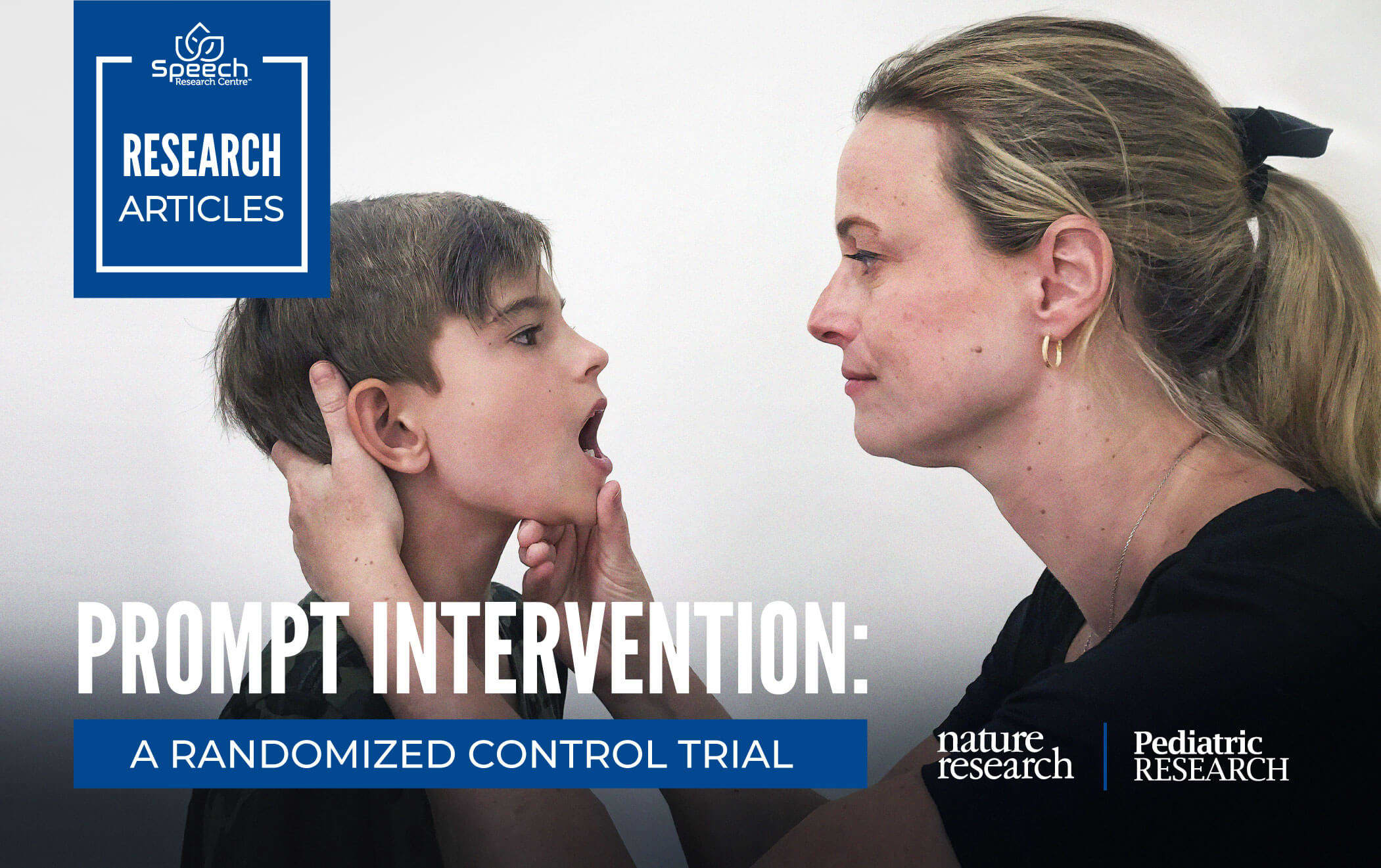
PROMPT intervention for children with severe speech motor delay: a randomized control trial.
Evidence-Informed Practice (previously known as Evidence-Based Practice) is an important concept in Speech-Language Pathology (S-LP). Speech-Language Pathologists and incoming students are strongly encouraged to critically examine research literature to inform their practice. Amongst the vast literature and study designs available, a Randomized Controlled Trial Design (RCT) is considered the "GOLD STANDARD" to establish cause-and-effect between treatment (independent variable) and observed changes in behaviour or therapy effects (dependent variable). However, the current state of research literature in the field of S-LP with this level of evidence is limited, particularly with respect to treatment for pediatric speech disorders.
In 2019, Dr. Aravind Namasivayam (Principal Investigator) and his co-investigator Dr. Pascal van Lieshout at the Department of Speech-Language Pathology (University of Toronto), successfully completed a large-scale, high-level treatment efficacy study on children with speech sound disorders (Subtype Speech Motor Delay) using a well-controlled RCT design. The study is the first of its kind to examine the treatment efficacy of the Prompts for Restructuring Oral Muscular Phonetic Targets (PROMPT) approach for this population. In the RCT design, 49 children with moderate-to-severe speech difficulties were first assessed at baseline (pre-treatment) and were then randomly allocated either to (1) an immediate intervention group (to receive 10 weeks of PROMPT intervention 45-min sessions 2x per week) or (2) a control group that was waitlisted for the same period and received routine home training instructions. Assessments were carried out following the 10-week intervention or waitlist/home training period.
Data collection for this five-year project spanned across three clinical sites in Ontario, namely the ErinoakKids Centre for Treatment and Development in Mississauga, The Speech and Stuttering Institute in Toronto, and The John McGivney Children's Centre of Essex County in Windsor. The project involved more than 40 research assistants, 14 Speech-Language Pathologists and assessors, and 49 participants. Dr. Namasivayam says the results provide critical new information.
The study clearly demonstrated that PROMPT intervention results in statistically and clinically significant, positive changes in speech motor control skills, articulation, speech severity and word-level speech intelligibility in children with moderate-to-severe speech difficulties. Dr. Namasivayam shares, "For the first time, the study provides a clear indication of the magnitude of intervention-related change for this population above and beyond developmental changes (i.e. maturation) and home training activities, clearly supporting the need for direct S-LP intervention for this population."
Dr. Namasivayam has presented the study results with his co-authors at the annual American Speech-Language-Hearing Association's convention in Boston in November 2018. The article is currently published in the prestigious Nature.com journal-Pediatric Research (https://www.nature.com/articles/s41390-020-0924-4).
As a clinician, how should I interpret the PROMPT RCT study findings?
As a researcher, I am obliged to show how our study provided clinical benefits to the study population (not only report statistical significance). Overall, 10-weeks of PROMPT intervention demonstrated statistically and clinically significant as well as meaningful improvements in children with severe speech motor disorders (Subtype Speech Motor Delay). The table below explains how the measurements and statistics in the study can be clinically interpreted.
|
The table describes the clinical interpretation of changes in outcome measures following 10-weeks of the PROMPT intervention relative to the waitlist/home training control group. (Note: All the table changes are statistically significant p 0.05; PROMPT RCT study; Namasivayam et al., 2020 published in Pediatric Research (https://www.nature.com/articles/s41390-020-0924-4). |
|||
|---|---|---|---|
| Measurements | Effect Size | Interpretation of Results | Clinical Significance |
|
Verbal Motor Production Assessment for Children - Focal Oromotor Control. Standardized assessment of speech motor skills, i.e., movement/ coordination of lips, tongue, jaw. |
6% increase |
3-year-old child: 6% increase in speech motor skills = approaching the average skills for normal/typically developing children after PROMPT treatment. > 3-year-old child: 6% increase in speech motor skills = change from a severe to a mild deficit after PROMPT treatment. |
Clinically significant and meaningful improvement. Implies PROMPT intervention facilitates the normalization of speech motor skills (Hayden & Square, 1999). |
|
Probe Word Scores. Criterion-referenced; 40 item word list to assess speech motor skills. |
28-point increase |
Indicates 9% improvement in speech motor skills. |
Clinically significant and meaningful improvement. Change is similar to VMPAC and those reported in the literature (Namasivayam et al., 2013; Square et al., 2014.) |
|
Speech Articulation Standardized assessment: DEAP test. |
5 standard score increase |
Indicates clinical improvement from 0.4 to 2nd percentile rank. |
Clinically significant and meaningful improvement. |
|
Percentage of Consonants Correct (PCC). |
10% increase |
Indicates clinical improvement of one level decrease in speech severity from severe to moderate-severe. |
Clinically significant and meaningful improvement (Issac & Michael, 1997; Shriberg et al., 1997). |
|
Word-level Speech Intelligibility. i.e., measures if words are understandable to unfamiliar listeners. Assessed using standardized Children's Speech Intelligibility measure (CSIM). |
8.5% increase |
Indicates clinical improvement outside of maturation (i.e., natural development) and measurement error. |
Clinically significant and meaningful improvement (Issac & Michael, 1997; Shriberg et al., 1997). (Namasivayam et al., 2013; Namasivayam et al., 2015; Wilcox & Morris, 1999). |
Namasivayam, A. K., Huynh, A., Granata, F., Law, V., & Van Lieshout, P.H.H.M.
(2020).
PROMPT intervention for children with severe speech motor delay:
a randomized control
trial. Pediatric Research, 1-10. Doi:
https://doi.org/10.1038/s41390-020-0924-4